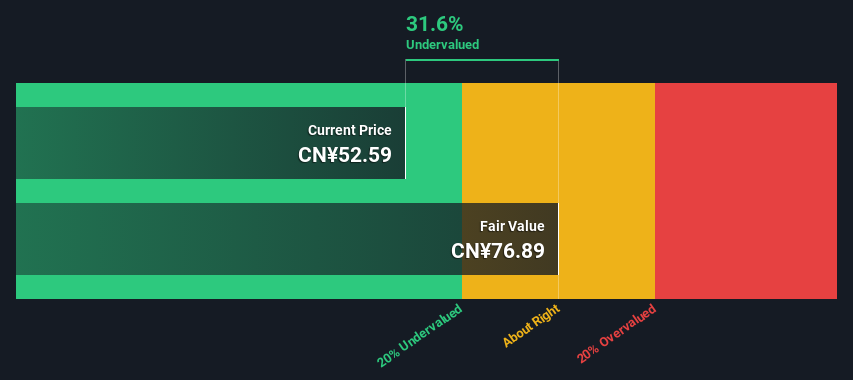Spring Airlines Co., Ltd.'s (SHSE:601021) Intrinsic Value Is Potentially 46% Above Its Share Price

Key Insights
- Using the 2 Stage Free Cash Flow to Equity, Spring Airlines fair value estimate is CN¥76.89
- Current share price of CN¥52.59 suggests Spring Airlines is potentially 32% undervalued
- Our fair value estimate is 18% higher than Spring Airlines' analyst price target of CN¥65.36
Today we will run through one way of estimating the intrinsic value of Spring Airlines Co., Ltd. (SHSE:601021) by taking the expected future cash flows and discounting them to their present value. This will be done using the Discounted Cash Flow (DCF) model. It may sound complicated, but actually it is quite simple!
We generally believe that a company's value is the present value of all of the cash it will generate in the future. However, a DCF is just one valuation metric among many, and it is not without flaws. If you want to learn more about discounted cash flow, the rationale behind this calculation can be read in detail in the Simply Wall St analysis model.
See our latest analysis for Spring Airlines
The Method
We are going to use a two-stage DCF model, which, as the name states, takes into account two stages of growth. The first stage is generally a higher growth period which levels off heading towards the terminal value, captured in the second 'steady growth' period. To start off with, we need to estimate the next ten years of cash flows. Where possible we use analyst estimates, but when these aren't available we extrapolate the previous free cash flow (FCF) from the last estimate or reported value. We assume companies with shrinking free cash flow will slow their rate of shrinkage, and that companies with growing free cash flow will see their growth rate slow, over this period. We do this to reflect that growth tends to slow more in the early years than it does in later years.
A DCF is all about the idea that a dollar in the future is less valuable than a dollar today, and so the sum of these future cash flows is then discounted to today's value:
10-year free cash flow (FCF) forecast
| 2025 | 2026 | 2027 | 2028 | 2029 | 2030 | 2031 | 2032 | 2033 | 2034 | |
| Levered FCF (CN¥, Millions) | CN¥2.37b | CN¥3.01b | CN¥3.50b | CN¥3.93b | CN¥4.30b | CN¥4.62b | CN¥4.90b | CN¥5.15b | CN¥5.38b | CN¥5.59b |
| Growth Rate Estimate Source | Analyst x2 | Analyst x2 | Est @ 16.25% | Est @ 12.23% | Est @ 9.42% | Est @ 7.45% | Est @ 6.07% | Est @ 5.10% | Est @ 4.43% | Est @ 3.95% |
| Present Value (CN¥, Millions) Discounted @ 8.2% | CN¥2.2k | CN¥2.6k | CN¥2.8k | CN¥2.9k | CN¥2.9k | CN¥2.9k | CN¥2.8k | CN¥2.7k | CN¥2.6k | CN¥2.5k |
("Est" = FCF growth rate estimated by Simply Wall St)
Present Value of 10-year Cash Flow (PVCF) = CN¥27b
We now need to calculate the Terminal Value, which accounts for all the future cash flows after this ten year period. The Gordon Growth formula is used to calculate Terminal Value at a future annual growth rate equal to the 5-year average of the 10-year government bond yield of 2.9%. We discount the terminal cash flows to today's value at a cost of equity of 8.2%.
Terminal Value (TV)= FCF2034 × (1 + g) ÷ (r – g) = CN¥5.6b× (1 + 2.9%) ÷ (8.2%– 2.9%) = CN¥107b
Present Value of Terminal Value (PVTV)= TV / (1 + r)10= CN¥107b÷ ( 1 + 8.2%)10= CN¥48b
The total value, or equity value, is then the sum of the present value of the future cash flows, which in this case is CN¥75b. To get the intrinsic value per share, we divide this by the total number of shares outstanding. Compared to the current share price of CN¥52.6, the company appears quite undervalued at a 32% discount to where the stock price trades currently. The assumptions in any calculation have a big impact on the valuation, so it is better to view this as a rough estimate, not precise down to the last cent.

The Assumptions
The calculation above is very dependent on two assumptions. The first is the discount rate and the other is the cash flows. If you don't agree with these result, have a go at the calculation yourself and play with the assumptions. The DCF also does not consider the possible cyclicality of an industry, or a company's future capital requirements, so it does not give a full picture of a company's potential performance. Given that we are looking at Spring Airlines as potential shareholders, the cost of equity is used as the discount rate, rather than the cost of capital (or weighted average cost of capital, WACC) which accounts for debt. In this calculation we've used 8.2%, which is based on a levered beta of 1.084. Beta is a measure of a stock's volatility, compared to the market as a whole. We get our beta from the industry average beta of globally comparable companies, with an imposed limit between 0.8 and 2.0, which is a reasonable range for a stable business.
SWOT Analysis for Spring Airlines
- Debt is not viewed as a risk.
- Dividend is low compared to the top 25% of dividend payers in the Airlines market.
- Annual earnings are forecast to grow for the next 3 years.
- Good value based on P/E ratio and estimated fair value.
- Dividends are not covered by cash flow.
- Annual earnings are forecast to grow slower than the Chinese market.
Moving On:
Valuation is only one side of the coin in terms of building your investment thesis, and it is only one of many factors that you need to assess for a company. The DCF model is not a perfect stock valuation tool. Preferably you'd apply different cases and assumptions and see how they would impact the company's valuation. For instance, if the terminal value growth rate is adjusted slightly, it can dramatically alter the overall result. Can we work out why the company is trading at a discount to intrinsic value? For Spring Airlines, we've compiled three relevant aspects you should assess:
- Risks: For example, we've discovered 1 warning sign for Spring Airlines that you should be aware of before investing here.
- Future Earnings: How does 601021's growth rate compare to its peers and the wider market? Dig deeper into the analyst consensus number for the upcoming years by interacting with our free analyst growth expectation chart.
- Other Solid Businesses: Low debt, high returns on equity and good past performance are fundamental to a strong business. Why not explore our interactive list of stocks with solid business fundamentals to see if there are other companies you may not have considered!
PS. The Simply Wall St app conducts a discounted cash flow valuation for every stock on the SHSE every day. If you want to find the calculation for other stocks just search here.
If you're looking to trade Spring Airlines, open an account with the lowest-cost platform trusted by professionals, Interactive Brokers.
With clients in over 200 countries and territories, and access to 160 markets, IBKR lets you trade stocks, options, futures, forex, bonds and funds from a single integrated account.
Enjoy no hidden fees, no account minimums, and FX conversion rates as low as 0.03%, far better than what most brokers offer.
Sponsored ContentNew: Manage All Your Stock Portfolios in One Place
We've created the ultimate portfolio companion for stock investors, and it's free.
• Connect an unlimited number of Portfolios and see your total in one currency
• Be alerted to new Warning Signs or Risks via email or mobile
• Track the Fair Value of your stocks
Have feedback on this article? Concerned about the content? Get in touch with us directly. Alternatively, email editorial-team (at) simplywallst.com.
This article by Simply Wall St is general in nature. We provide commentary based on historical data and analyst forecasts only using an unbiased methodology and our articles are not intended to be financial advice. It does not constitute a recommendation to buy or sell any stock, and does not take account of your objectives, or your financial situation. We aim to bring you long-term focused analysis driven by fundamental data. Note that our analysis may not factor in the latest price-sensitive company announcements or qualitative material. Simply Wall St has no position in any stocks mentioned.
About SHSE:601021
Spring Airlines
Engages in the air passenger and cargo transportation business in China.
Moderate growth potential with mediocre balance sheet.
Similar Companies
Market Insights
Community Narratives



